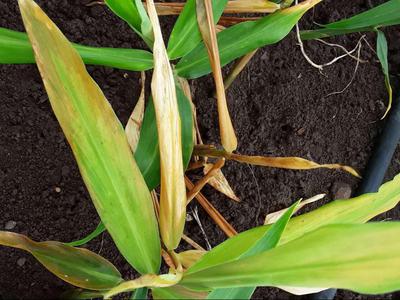Rhizome Rot
Pythium aphanidermatum
Fungus
In a Nutshell
- Yellow leaves.
- Rotten roots.
- Brown discolouration of rhizome tissue.
Can also be found in
Symptoms
The infection begins at the collar region of the pseudostems and moves upwards and downwards. The collar region of the affected pseudostems become water-soaked and the rotting spreads to the rhizome. At a later stage, root infection is also noticed. Foliar symptoms appear as light yellowing of the tips of lower leaves, which gradually spread to the leaf blades. In the early stages of infection, the middle portion of the leaves remains green while the margins become yellow. The yellowing is followed by drooping, withering and drying of the pseudostems.
Recommendations

Organic Control
Apply cow dung slurry or liquid manure after each mulching to enhance microbial activity and nutrient availability. Use resistant or tolerant varieties for planting. Practice crop rotation with maize, cotton or soybean. Antagonistic species of Trichoderma such as T. viride, T. harzianum and T. hamatum are known to inhibit the growth of the pathogenic fungi (40g/sq.m).

Chemical Control
Always consider an integrated approach, using both preventive measures together with biological treatments, if available. Treat seed rhizomes with mancozeb 0.3% for 30 minutes before storage and before planting to reduce disease incidence.
What caused it?
The disease is caused by the soil-borne fungus of Pythium aphanidermatum, which multiplies with the buildup of soil moisture with the onset of southwest monsoon. The fungus can survive in two ways. One, it survives in diseased rhizomes kept for seeds, and secondly, by resting structures like chlamydospores and oospores that reach the soil from infected rhizomes. Younger sprouts are the most susceptible to the pathogen and the disease is aggravated by nematode infestation. A high temperature of above 30°C and high soil moisture are important predisposing factors that favour the disease. Waterlogged conditions in the field due to poor drainage also increase the disease intensity in the field.
Preventive Measures
- Ensure proper drainage, and select well-drained soils for planting.
- Adopt phytosanitary measures like removing and destroying infected plants.
- Mulch with green leaves (Vitex negundo) @ 4-4.8t/acre at the time of the planting.
- Repeat @ 2t/acre at 40 to 90 days after planting.
- Follow at least 2-3 years of crop rotation.
- Apply neem cake @ 250g/sq.m and lime as a soil amendment.


